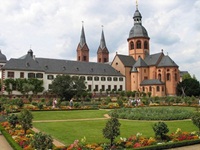Course outline
Places of interest around Aschaffenburg:
Klingenberg am Main
The mediaeval castle Clingenburg, built in 1177, is situated just above the town of Klingenburg and its picturesque vineyards. Klingenberg’s historical town center is famous for its timber-framed buildings dating back to the 16th century, in particular the Old Town Hall (Altes Rathaus) from 1561(today a tourist information centre). The Stadtschloss („Town Palace”), a Renaissance building from 1560, is another architectural gem located nearby.
Access: 22 minutes by train
Google Map:
- Klingenberg Town
- Clingenburg Festival (Open Air Theatre)
- Red Wine Hiking Trail
The Moated Castle of Mespelbrunn in the Spessart
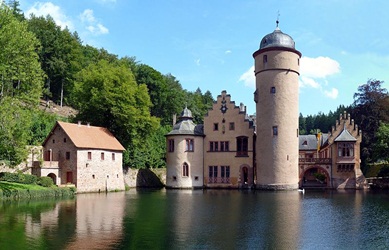 |
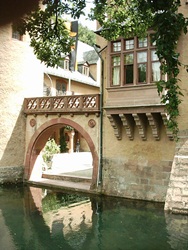 |
When archbishop Johann von Mainz bestowed the „Platz zum Espelborn“ to Hamann Echter for his loyal services in 1412, the Spessart was nothing more than dark forests of unexplored wilderness. Hamann Echter’s son by the same name gave up his father’s unfortified building by the pond and replaced it with a “solid house”, fortified with strong walls and towers. Owing to more peaceful times, successive generations transformed the crude moated building into a fairy-tale Renaissance castle. Thanks to its secluded location, the moated castle of Mespelbrunn was able to survive the fogs of war, retaining its picturesque appearance. The castle is open to visitors from Good Friday to All Hallows.
Access: Aschaffenburg train station/bus terminal 34 minutes
Link: Hiking Trails Mespelbrunn:
Seligenstadt
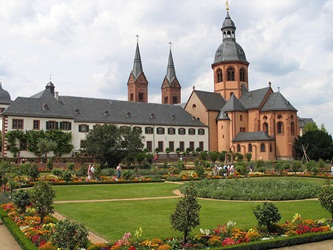 |
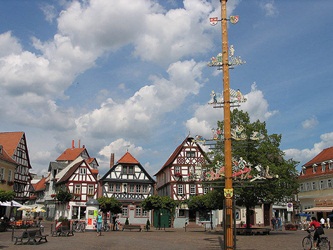 |
During the reign of the Roman emperor Trajan around 100 AD Roman cohorts erected a castra (fort) on the grounds of what would once become Seligenstadt’s market place and old town. Around 830 construction work on the Einhard Cathedral, the town’s landmark, commenced, and in the year 1028 Seligenstadt was the venue of a Roman-Catholic synod that resulted in the introduction of ember days and strict rules of fasting. In 1063 Emperor Heinrich IV. confirmed the archbishop of Mainz as the rightful owner of the abbey. In 1188, Emperor Frederick Barbarossa held court in Seligenstadt. It was during his reign that the town obtained town rights and a royal palace was built on the banks of the Main river.
Access: Aschaffenburg Sta. – Seligenstadt (Hessen): 21 minutes by train
Link:
Miltenberg

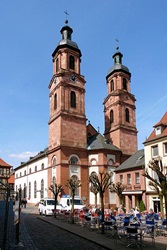 |
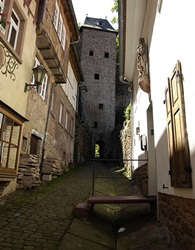 |
Around 155 AD the Romans connected the „Further Limes” straight south to the Main river around the current location of Miltenberg. Remains of two Roman castrae (forts) can be found between Miltenberg and the towns of Kleinheubach and Bürgstadt. The town of Miltenberg sprawled around Miltenburg Castle erected around 1200 AD and was first recorded in 1237.
Links:
Wuerzburg
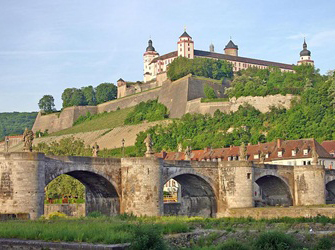 |
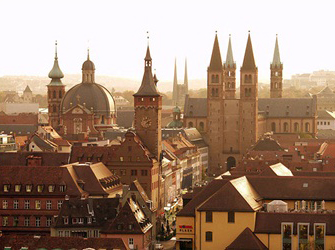 |
The renowned Residence Palace with its Hofgarten and the surrounding residential square was registered as a UNESCO World Cultural Heritage Site in 1981. In 2004 Wuerzburg celebrated its 1300-year anniversary
Access: Aschaffenburg Sta. - Würzburg Sta.: 39 minutes (by ICE)
Link:
Frankfurt am Main
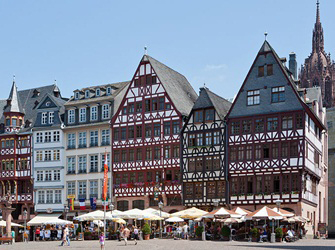 |
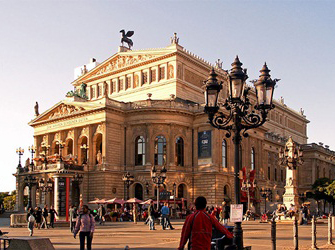 |
Since the Middle Ages, Frankfurt has been regarded as one of the major urban centres in Germany. First recorded in 794, it later became a Free Imperial Town (“Freie Reichsstadt”) and served until 1806 as the venue where the Holy Roman Emperors were elected and crowned. Between 1816 and 1866 Frankfurt was the seat of the German Confederation (Deutscher Bund) as well as the location of the first freely elected German parliament in 1848/49.
Access: Aschaffenburg Sta. - Frankfurt Central Sta.: 28 minutes by train
Google: Map
Link:
